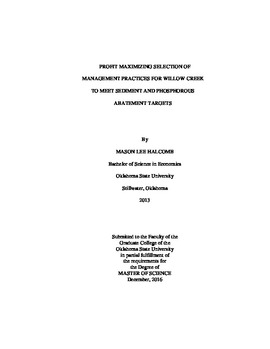| dc.contributor.advisor | Stoecker, Arthur | |
| dc.contributor.author | Halcomb, Mason Lee | |
| dc.date.accessioned | 2018-06-29T14:40:59Z | |
| dc.date.available | 2018-06-29T14:40:59Z | |
| dc.date.issued | 2016-12-01 | |
| dc.identifier.uri | https://hdl.handle.net/11244/300346 | |
| dc.description.abstract | Fort Cobb Reservoir is located in Caddo County in the southwest region of Oklahoma. The lake has been experiencing high levels of sedimentation and phosphorous loading, primarily from agricultural land, which has resulted in a degradation of reservoir services for municipal and recreational use. The main way sediment and phosphorous originating from field surfaces has been abated is through voluntary enrollment in cost sharing programs. The objective of this study was to use the Environmental Policy Integrated Climate (EPIC) modeling tool to simulate erosion levels and phosphorous losses in the Willow Creek sub watershed with alternative management practices on wheat and cotton fields, including conversion to native grassland. A linear programming model was used to maximize net farm revenue while meeting abatement targets. A binary programming model was used to maximize net farm revenue while meeting targets while limiting each farm to a single improved management practice. Land owners with more than 40 acres and cotton or wheat production were included in the model. Slopes between 0 and 2 percent for cotton and 0 and 5 percent for wheat across the 19 most common soil types in the sub watershed were considered. Solutions for 40, 60, and 80 percent abatement of phosphorus and sediment together and sediment alone were determined. Net revenues for the watershed at each abatement level are included. The economic feasibility of using a binary programming model which requires a single management practice for each farm is demonstrated. No till is shown to have the lowest economic cost while providing all necessary abatements at lower targets. Grassland was determined to have the highest economic cost while also providing the highest abatement levels. Soil types with slopes, hectarage, erosion, and phosphorous loss with disk chisel, no till, contour, contour and no till, and conversion to native grassland are show. | |
| dc.format | application/pdf | |
| dc.language | en_US | |
| dc.rights | Copyright is held by the author who has granted the Oklahoma State University Library the non-exclusive right to share this material in its institutional repository. Contact Digital Library Services at lib-dls@okstate.edu or 405-744-9161 for the permission policy on the use, reproduction or distribution of this material. | |
| dc.title | Profit Maximizing Selection of Management Practices for Willow Creek to Meet Sediment and Phosphorous Abatement Targets | |
| dc.contributor.committeeMember | Epplin, Francis | |
| dc.contributor.committeeMember | Jones, Rodney | |
| osu.filename | Halcomb_okstate_0664M_14939.pdf | |
| osu.accesstype | Open Access | |
| dc.description.department | Agricultural Economics | |
| dc.type.genre | Thesis | |
| dc.type.material | text | |
